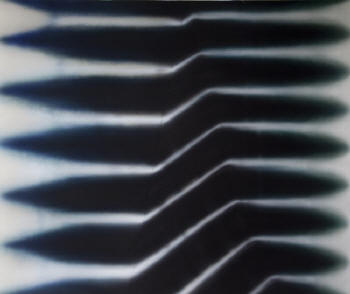|
|
| home | features | exhibitions | interviews | profiles | webprojects | gazetteer | links | archive | forum |
|
Barrie Cook Alex Wade
Sometimes, as I set off to interview one of Cornwall’s artists, I feel nervous. Many are preceded by their reputations, and while the pre-publicity is generally good it occasionally casts them as aloof and mercurial or, yet more worryingly, downright difficult.
Cook shook my hand with one of his mischievous smiles. Eyes twinkling, he explained how he and his wife, Mary, had come to acquire what is surely one of the most remarkable studios in Cornwall. Light-filled, dusty, its two floors bursting with Cook’s work and its walls oozing history, the Old Methodist Hall dates back to the mid-1870s and was bought by Cook after he saw it on his way to the pub. “We’d fallen in love with Cornwall, especially the far end of the Lizard,” says Cook, “and we loved the look of the Methodist Hall. Mary said we needed to get it surveyed before we even thought about buying it.” Cook’s response was typically pragmatic. “I said, ‘If we do, we’ll never buy it’.” Soon enough – and certainly before there was time to think twice - Cook had bought the Hall from a friend in the merchant navy.
It is a way of life which is far removed from Cook’s metropolitan roots. Born in Birmingham in 1929, Cook’s upbringing was in the Midlands, becoming a keen Aston Villa supporter, running for Birchfield Harries and playing rugby for Walsall. If his sporting prowess is atypical among artists, so too was his early work as a physical fitness instructor in the RAF. Life in the services, though, is not something Cook looks back on with fondness. He is profoundly anti-war, and, remembering those days – when men of Cook’s age were subject to wartime emergency regulations compelling service – a shadow passes Cook’s normally ebullient features. But following his spell in the RAF, Cook embarked on an artistic journey which has seen him become one of Britain’s most distinctive modern artists. He had always shown artistic flair at school and, post-RAF, began a five year course in fine art at Birmingham College of Art. At the same time he worked as a junior commercial artist, but his main preoccupation then may surprise those who know Cook’s oeuvre of the past 30 years, one described by Paul Moorhouse as characterised by “an almost unbroken allegiance to spray-painting.” As a young man, Cook’s fascination was with watercolours, their inspiration being the cliffs and sea of the Cornish coast around St Ives, which he visited with his parents on holidays as a child.
But the lure of Cornwall proved to be irresistible. By 1992, when he settled in the Lizard, Cook had been working as a professional artist for nearly decade, with solo shows at the Serpentine Gallery in London and the National Museum of Wales, among others, to his name. Memories of childhood holidays in Cornwall and later meetings with the likes of Sir Terry Frost helped cement the decision to move from Cardiff. “I met Terry through Adrian Heath,” recalls Cook. “He was older but a kindred spirit.” And upon moving to Cornwall, Cook’s art underwent a change. “Having worked from a studio in Cardiff’s docklands my work had a certain industrial ambience,” he says. “Once I moved to Cornwall my palette lightened.” As a painter, Cook soon departed the realm of the figurative watercolour. Along with Heath, who met Frost while the pair were prisoners of war and also taught Ben Nicholson, Cook credits Harry Thubron as being a formative influence. Thubron played a key role in the development of what is now the Foundation Course in art, and his ideas, as well as the strong colours and geometric shapes in works by Sonia Delaunay, Frank Stella and Russian Suprematists such as Kliun and Malevich, all resonated with Cook. But as befits a man whose work is in the Tate Britain as well as a number of important collections worldwide, Cook’s unique style was evident at the outset.
For many years Cook has exhibited in Cornwall with the Lemon Street Gallery in Truro. He has the highest regard for its director, Louise Jones, saying that “she is as passionate about her gallery as I am about my painting.” At 80 years old, there is no dimming of Cook’s passion, as is ably demonstrated by the work at his latest Lemon Street show. As I say my farewells, it strikes me that though there may be contradictions in Cook – ranging from his being both sportsman and artist, a reluctant PTI in the RAF, an ostensibly formal painter whose work is yet emotive and emotional, all the way to this sociable man’s choice of an old Methodist hall as his studio – one thing has always been, and still is, certain: Barrie Cook is one of the most likeable, unpretentious artists you’ll ever meet. He’s also one of the best.
Barrie Cook was at Lemon Street Gallery, Truro, Cornwall from 10/10/09 - 07/11/09 First published in Cornwall Today. Images courtesy of Lemon Street Gallery. |
|
|




